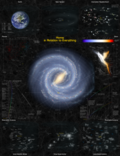
Grootte van deze voorvertoning: 461 × 599 pixels. Andere resoluties: 185 × 240 pixels | 369 × 480 pixels | 591 × 768 pixels | 788 × 1.024 pixels | 1.577 × 2.048 pixels | 8.859 × 11.506 pixels.
Oorspronkelijk bestand (8.859 × 11.506 pixels, bestandsgrootte: 75,71 MB, MIME-type: image/png)
Bestandsgeschiedenis
Klik op een datum/tijd om het bestand te zien zoals het destijds was.
| Datum/tijd | Miniatuur | Afmetingen | Gebruiker | Opmerking | |
|---|---|---|---|---|---|
| huidige versie | 28 mrt 2019 13:12 |  | 8.859 × 11.506 (75,71 MB) | RolandWinkler | Fixed a small error in the scale of the Earth, top-left panel. The numbers read now the correct distance from Earth centre (instead of half the correct distance as before). |
| 5 nov 2015 17:29 |  | 8.859 × 11.506 (75,89 MB) | Reaper35 | Reverted to version as of 11:41, 15 April 2013 (UTC): No more need for this, should work fine now. | |
| 15 apr 2013 14:13 |  | 2.953 × 3.835 (11,71 MB) | RolandWinkler | Reduced the resolution so that it can be displayed in thumbnails. | |
| 15 apr 2013 13:41 |  | 8.859 × 11.506 (75,89 MB) | RolandWinkler | User created page with UploadWizard |
Bestandsgebruik
Geen enkele pagina gebruikt dit bestand.
Globaal bestandsgebruik
Dit bestand wordt op de volgende andere wiki’s gebruikt:
- Gebruikt op en.wikipedia.org
- Gebruikt op en.wikiquote.org
- Laurence J. Peter
- Arthur Eddington
- Wikiquote:Quote of the day/January 2014
- Wikiquote:Quote of the day/January 18, 2014
- Wikiquote:Quote of the day/March 2014
- Wikiquote:Quote of the day/March 11, 2014
- Wikiquote:Quote of the day/October 2014
- Wikiquote talk:Quote of the day/October 12, 2014
- Wikiquote:Quote of the day/October 12, 2014
- Wikiquote:Quote of the day/September 2017
- Wikiquote:Quote of the day/September 16, 2017
- Wikiquote:Quote of the day/June 2018
- Wikiquote:Quote of the day/June 16, 2018
- Wikiquote:Quote of the day/March 2021
- Wikiquote:Quote of the day/March 5, 2021
- Wikiquote:Quote of the day/June 2022
- Wikiquote:Quote of the day/June 23, 2022
- Gebruikt op fr.wiktionary.org
- Gebruikt op mg.wikipedia.org
- Gebruikt op pnb.wikipedia.org
- تارہ جھرمٹ
- شکاری تارہ جھرمٹ
- اسمانی کھڑی لیک
- جوڑی تارہ جھرمٹ
- ہالی تارہ جھرمٹ
- کاں تارہ جھرمٹ
- ڈولفن تارہ جھرمٹ
- چھینی تارہ جھرمٹ
- تیر تارہ جھرمٹ
- بچھو تارہ جھرمٹ
- گرگٹ تارہ جھرمٹ
- مور تارہ جھرمٹ
- گھُگی تارہ جھرمٹ
- پورس تارہ جھرمٹ
- ہنس تارہ جھرمٹ
- شینہ تارہ جھرمٹ
- پیگاسس تارہ جھرمٹ
- خلا
- خاندان مجمع النجوم
- جاثی (خاندان مجمع النجوم)
- کرہ سماوی
- سانچہ:معلومات-فلکیات
- سانچہ:معلومات-فلکیات/دستاویز
- اجرام فلکی
- Gebruikt op sg.wiktionary.org


 Français
Français Italiano
Italiano



